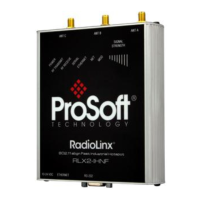RLX2 Series ♦802.11a, b, g, n Antenna Configuration
Industrial Hotspots User Manual
ProSoft Technology, Inc. Page 137 of 161
May 8, 2013
9.1.5 Collinear array antennas
A collinear array antenna is typically composed of several linear antennas
stacked on top of each other. The more stacked elements it has, the longer it is,
and the more gain it has. It is fed in on one end.
The antenna pattern is torroidal. Its azimuthal beamwidth is 360°
(omnidirectional). Its vertical beamwidth depends on the number of
elements/length, where more elements equal narrower beamwidth. The antenna
gain also depends on the number of elements/length, where more elements
produce higher gain. Typical gain is 5 to 10 dBi.
The antenna polarity is linear, or parallel to the length of the antenna.
9.1.6 Yagi Array Antenna
A yagi antenna is composed of an array of linear elements, each parallel to one
another and attached perpendicular to and along the length of a metal boom. The
feed is attached to only one of the elements. Elements on one side of the fed
element are longer and act as reflectors; elements on the other side are shorter
and act as directors. This causes the antenna to radiate in a beam out of the end
with the shorter elements. The pattern depends on the overall geometry,
including the number of elements, element spacing, element length, and so on.
Sometimes the antenna is enclosed in a protective tube hiding the actual
antenna geometry.
The antenna pattern (page 135) is a beam pointed along the boom toward the
end with the shorter elements. The beamwidth varies with antenna geometry but
generally is proportional to the length (where longer length produces a narrower
beam).
The antenna gain (page 136) varies with antenna geometry but generally is
proportional to the length (where longer length produces higher gain). Typical
values are 6 to 15dBi.

